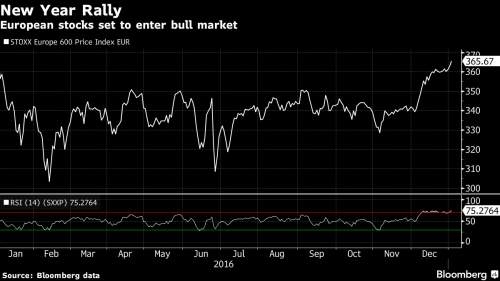Rumors of the Trumpflation rally’s death have been greatly exaggerated, and not only is the Dow 20,000 back on the radar, following a 124 point surge in Dow futures, bringing the “key psychological level” back within 100 points, but European stocks rose for a third day and entered a bull market, rising 20% from their lows set last February, following strong Chinese manufacturing and services PMI data, both of which ended 2016 on robust notes well inside expansion territory.

While much of Europe had been open on Monday, it was the first day back for its biggest stock market, Britain’s FTSE 100 and it wasted no time in hitting a new record high of 7,196 points with a 0.7% gain. Germany’s DAX and France’s CAC 40 climbed too and among individual stock movers, Italian banks were back amongst the top risers, with newly-merged Banco BPM up 4.6 percent on its second day of trading.Overall, the Stoxx Europe 600 Index advanced 0.8% at 8:33 a.m. in London, with 18 of 19 industry segments climbing. The benchmark index, up 20 percent since a low last February, will confirm a bull market should the day’s gains hold into the close. The U.K.’s FTSE 100 Index, trading for the first time in 2017, is up 0.7 percent and heading for a record close.
US equity futures on the S&P 500 Index rose 0.7 percent, back over 2,251, while the Dow Jones was set to open back over 19,900.
In a reversal from the first trading days of 2016, when a selloff in Chinese equities roiled markets globally, the world’s second-largest economy has been a source of strength at the start of 2017. Weekend reports showed China’s official factory gauge steadied while services remained robust, capping a year of improvement in both indicators. A private manufacturing measure released Tuesday came in better than anticipated.
“A year ago, the Chinese markets kept everyone on their toes,†said Jingyi Pan, a market strategist at IG Asia Pte. “A year later, the outlook certainly appears to be more optimistic, though we may have to bring back the catchphrase of ‘cautious optimism’ going into the new year as we search for clarity.†“I don’t think that we will see a repeat given that the global economy has a better foothold compared to a year ago,” Pan said.
Overnight in Asia, MSCI’s broadest index of Asia-Pacific shares rose 0.6 percent as most regional markets reopened after the New Year holiday although Japan’s Nikkei was still closed. Australian shares were the best performers in the region, closing up 1.2 percent. Hong Kong’s Hang Seng .HSI rose 0.7 percent while in China, both the CSI 300 index and the Shanghai Composite .climbed 1 percent.China was Asia’s worst performing major stock market in 2016 with a 11.3 percent loss in its worst year in five.
Commodity-linked stocks jumped 1.3 percent as oil and metals prices cheered the China data that had showed output from the country’s giant manufacturing sector reaching a near six-year high. It bolstered the ‘reflation’ theme that dominated the latter stages of 2016 and helped get currency and bond markets back in their pre-break rhythm after a mixed recent run. The U.S. dollar racked up its biggest rise in almost three weeks against a basket of the world’s other major currencies to leave it just 1 percent off December’s 14-year high. As shown in the chart below, the Dollar Index (DXY) jumped as US yields moved sharply higher, w/ 10y yields rising from 2.4350% to over 2.51%.

In commodities, oil prices jumped over 2% in Europe as the China data fed into a market that is being buoyed by hopes a deal including OPEC and non-OPEC producer countries will drain the recent global supply glut. Oil was the world’s best-performing major asset class in 2016, with a gain of around 50 percent and global benchmark Brent was up 2.7% at $58.31 by 0945 GMT as U.S. crude topped $55 a barrel.
“Markets will be looking for anecdotal evidence for production cuts,” Ric Spooner, chief market analyst at CMC Markets said. “The most likely scenario is OPEC and non-OPEC member countries will be committed to the deal, especially in early stages.”
The positive Chinese news lifted the Australian dollar, which added 0.6 percent to $0.7230, while gold sagged, with the precious metal dropping 0.3 percent to $1,148 an ounce. Back in Europe, the pick ups in Germany and French inflation came on the heels of data on Monday showing manufacturers ramped up activity at the fastest pace in more than five years in December.
In China, Starting on Jan. 1, the number of currencies in the CFETS basket increased to 24 from 13, with new entrants including the Korean won, the South African rand and the Mexican peso. The country’s foreign exchange regulator also said it would step up scrutiny of individuals’ foreign currency purchases and strengthen punishment for illegal outflows, although the $50,000 annual individual quota will remain unchanged. The renminbi posted its biggest annual loss since 1994 last year, with the dollar up almost 7 percent versus the Chinese currency.

